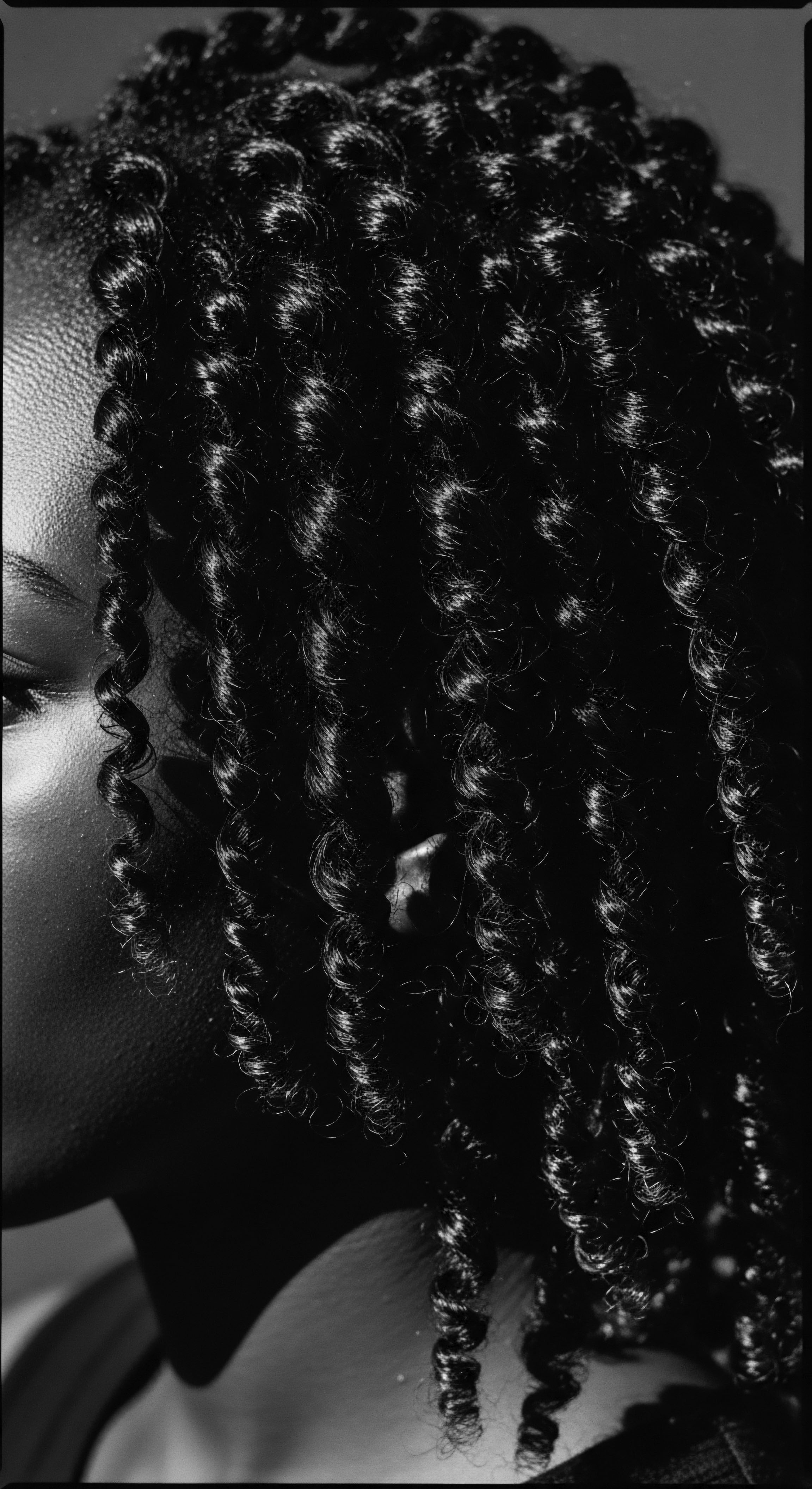
Roots
There exists a profound, enduring connection between the textured coil, the rich earth, and the ancestral hands that have long understood their deepest secrets. It is a story whispered across generations, carried on the Sahelian winds, and preserved within the very substance of Shea Butter. This golden balm, more than a simple commodity, serves as a living testament to the resilience, ingenuity, and profound wisdom held within Black and mixed-race hair heritage. When we speak of shea’s economic footprint, we are truly speaking of a legacy, one where the intricate dance of nature and human endeavor finds its rhythm in the hands of women, shaping not only livelihoods but also the very fabric of identity.
For millennia, the shea tree, Vitellaria paradoxa, has stood as a venerable matriarch across the vast savannahs of West and Central Africa. Its presence is not accidental; it is a deliberate, cultivated relationship spanning epochs, deeply woven into the daily existence and ceremonial practices of numerous communities. The tree itself, often referred to as a “gift from the gods” in West African oral histories, is considered sacred.
Traditions in places like northern Ghana and southern Burkina Faso prohibit felling them, and trees are sometimes planted to mark significant family events, such as childbirth or inheritance. This reverence underscores the deep spiritual ties that bind these communities to the source of shea, placing its biological existence squarely within a cultural framework.

What Ancestral Understanding Shapes Shea’s Use?
The journey of shea butter, from fruit to balm, is an enduring testament to ancient knowledge, passed meticulously from one generation of women to the next. This is not merely about production; it is about preservation—of technique, of knowledge, and of a heritage that recognizes the intrinsic value of natural elements for holistic wellbeing. Historically, women have been the primary guardians of the shea tree’s bounty, carrying out the labor-intensive process of converting the wild-gathered nuts into the revered butter. This ancestral understanding extends to the very anatomy of the hair itself.
Our ancestors observed that textured hair, with its unique helical structure and tendency toward dryness, greatly benefited from rich, emollient substances. Shea butter, with its distinctive composition, became a cornerstone of this care.
The journey of shea butter from tree to balm represents an unbroken lineage of ancestral wisdom and self-sufficiency.
The traditional method of shea butter extraction, practiced for centuries, highlights this deep understanding. After the fruits fall naturally from the tree—a process seen as the tree offering its bounty—women collect the nuts. These are then carefully dried, roasted, cracked, and ground into a paste. Water is then added, and the paste is kneaded until the butter separates.
This methodical approach, often involving collective effort within communities, speaks to a communal economy that precedes modern market structures. The care with which each step is performed ensures the butter retains its potent properties, making it an ideal ingredient for maintaining the health and vitality of textured hair.
The very composition of shea butter, rich in vitamins A and E, alongside a complex array of fatty acids like oleic, stearic, and linoleic acids, speaks to its remarkable properties. These components, intuitively understood through generations of application, provide intense moisture, protect against environmental stressors, and offer a soothing balm for the scalp. This scientific validation of ancient practices underscores the profound connection between elemental biology and the inherited wisdom of care. It is a testament to how traditional knowledge systems, often dismissed in the past, hold sophisticated insights into natural resources and their applications.
| Traditional Step Nut Collection |
| Purpose and Heritage Link Gathering fallen fruits, respecting the tree's natural cycle and perceived 'offering'. |
| Traditional Step Drying and Cracking |
| Purpose and Heritage Link Sun-drying preserves the nuts; careful cracking extracts kernels, a skill passed mother to daughter. |
| Traditional Step Roasting and Grinding |
| Purpose and Heritage Link Develops unique nutty scent, breaks down structure for butter extraction, often a communal task. |
| Traditional Step Kneading and Separating |
| Purpose and Heritage Link The most labor-intensive step, where women's hands transform paste into rich butter, a symbol of their enduring labor and skill. |
| Traditional Step Cooling and Solidifying |
| Purpose and Heritage Link Allows the butter to set, ready for use or trade, maintaining its natural integrity. |
| Traditional Step These ancestral steps are the foundation of shea's economic role, reflecting a deep respect for both resource and tradition. |
Beyond its physical attributes, shea butter holds a symbolic weight within African traditions, signifying health, protection, and prosperity. It has been used for centuries for baby care, wound healing, and as a soothing balm. This cultural integration highlights how its economic role is not merely transactional; it is deeply embedded in social structures and wellbeing practices, particularly for women who are often at the nexus of household health and community care. The sustained use of shea butter by African women for thousands of years, as recorded in historical accounts, underscores its status as a timeless treasure.
Indeed, legendary figures like Queen Cleopatra are said to have prized shea for its protective qualities, transporting it across vast distances in clay jars. This historical usage, documented by travelers like Ibn Battuta in the 14th century, confirms its long-standing socio-cultural and economic importance across the continent.
The economic role of women in the shea industry is not a modern construct; it is a continuation of these ancient practices, adapted to contemporary demands. The enduring presence of women in every stage, from wild harvesting to local processing, ensures the continuity of traditional knowledge and cultural connection. Their hands, shaped by generations of this work, carry the essence of an unbroken heritage, making shea not just a product, but a testament to a way of life.

Ritual
The journey of shea from a wild fruit to a celebrated balm has always been intertwined with the careful rituals of care, particularly those concerning textured hair. These rituals, steeped in ancestral wisdom, reveal how women’s hands have long shaped both cultural expression and economic viability within the shea industry. The act of applying shea butter to hair is not simply a cosmetic step; it is a profound connection to lineage, a recognition of natural beauty, and a continuation of practices that have sustained generations of Black and mixed-race communities.

How Does Shea Influence Traditional Hair Styling?
For centuries, the women of the Sahel region have relied on shea butter as a fundamental element in their hair care regimens, specifically tailored for the unique needs of textured hair. Its rich, emollient qualities make it ideal for sealing moisture, adding shine, and reducing frizz—properties that are especially valuable for coils and curls prone to dryness. These applications are not arbitrary; they are the result of countless generations observing, refining, and passing down techniques that understood the hair’s biology long before modern science articulated it.
Consider the practice of Hair Oiling, a tradition deeply embedded in many African societies. Shea butter, often warmed to a soft consistency, would be massaged into the scalp and along the hair strands, a ritual serving multiple purposes. Beyond its immediate conditioning benefits, this act fostered connection—mothers caring for children, sisters tending to each other, elders imparting wisdom.
This communal aspect of hair care reinforced social bonds, making the economic activity surrounding shea a deeply social endeavor. The shea, collected and processed by these same women, became a tangible link within these intimate heritage spaces.
The role of shea in Protective Styling is also significant. Styles such as braids, twists, and various forms of coiling have been used for centuries to safeguard textured hair from environmental damage, breakage, and manipulation. Shea butter served as a vital component in preparing the hair for these styles, providing a slip that eased detangling and a protective layer that maintained moisture within the styled strands.
This protective function extended the longevity of styles, thereby reducing daily manipulation and promoting hair health. The women who crafted these styles, and who prepared the shea, were artisans of appearance and wellness, their economic role inseparable from their cultural contribution.
Even the earliest forms of hair ornamentation and cultural adornment often utilized shea butter. It was used to soften and prepare hair for the incorporation of cowrie shells, beads, or fibers, ensuring the hair remained pliable and resilient. These adorned styles, beyond their aesthetic appeal, often conveyed social status, marital status, or tribal affiliation. The economic activity of processing shea, then, directly supported these complex cultural expressions, with women playing a dual role as both producers of the raw material and custodians of its application in cultural artistry.
- Deep Conditioning ❉ Shea butter acts as a sealant, helping to lock in moisture within the hair shaft, which is crucial for maintaining the hydration of textured hair.
- Scalp Care ❉ Its soothing properties make it beneficial for dry or irritated scalps, reflecting traditional uses for various skin ailments.
- Styling Aid ❉ Used to prepare hair for traditional protective styles, providing pliability and reducing friction during braiding or twisting.
The shift towards more mechanized processing methods in some parts of the shea value chain presents both opportunities and challenges. While machinery can reduce the intense physical labor associated with traditional hand-processing, it also introduces questions about who benefits from this efficiency and whether the ancestral methods, with their inherent quality controls and community building aspects, are being preserved. Women in the industry often face barriers in accessing these more advanced technologies or the capital required to invest in them. The economic landscape may change, yet the enduring legacy of women’s hands and knowledge remains the bedrock of shea production.
From ancient protective styles to modern conditioning, shea butter has been a steadfast ally in the textured hair journey.
The market for shea butter today, particularly in the global beauty industry, often seeks specific grades and quantities, which can sometimes incentivize large-scale, less traditional processing. Yet, the appeal of “raw” or “unrefined” shea butter persists, driven by a growing appreciation for its natural integrity and the authentic connection to its origins. This demand implicitly honors the traditional methods predominantly carried out by women. When a consumer chooses ethically sourced, traditionally processed shea, they are unknowingly participating in an ancient economic ritual, supporting the women who continue this inherited practice.
The economic agency of women within these rituals is undeniable. Whether through direct sales of traditionally processed shea at local markets or through participation in cooperatives that connect them to international buyers, women leverage their inherited skills for financial gain. This income, often earned during the lean agricultural season, provides critical support for their families, covering necessities like school fees, healthcare, and food.
In many West African households, shea butter income can account for a significant portion of cash available, sometimes up to 32%. This demonstrates how these ancient rituals of care translate directly into tangible economic power, reinforcing their standing within their families and communities.

Relay
The economic role of women in the shea industry is a vibrant, intricate story, reflecting both deep-rooted tradition and evolving global dynamics. It is a testament to collective female agency, shaping not only regional economies but also impacting global supply chains, often invisibly to the end consumer. Across the vast “shea belt” of Africa, stretching from Senegal to Uganda, approximately 16 million women depend on the shea tree for their sustenance and livelihood. This staggering figure underscores the industry’s singular reliance on women’s labor and expertise, making shea truly “women’s gold” in a deeply meaningful sense.

How Do Women Shape Shea’s Economic Landscape?
The economic contribution of women begins at the very earliest stage of the shea value chain ❉ the collection of shea nuts. Shea trees grow wild; they are not cultivated in plantations, meaning women spend countless hours, often walking many kilometers, searching for and gathering the fallen fruits. This arduous, often solitary work is foundational to the entire industry, yet it is largely unpaid labor within the household economy, or poorly compensated if the nuts are sold raw.
This initial stage, while critical, also exposes women to environmental hazards, including snakebites and scorpion stings. Despite these dangers and the demanding nature of the work, women’s dedication to this ancestral practice remains unwavering, driven by the economic imperative it represents for their families.
Moving beyond collection, women dominate the labor-intensive processing of shea nuts into butter. This traditional transformation involves a series of physical steps ❉ boiling, drying, crushing, roasting, grinding, and prolonged kneading. These processes, traditionally performed by hand, demand immense physical strength and time. A study in Burkina Faso revealed that 94% of women involved in shea activities were engaged solely in nut collection, while a significant portion also participated in commercialization.
However, their participation in more profitable segments of the value chain has historically been limited, with men often controlling the higher-value activities such as large-scale trading or mechanized processing. This disparity highlights a persistent challenge within the industry ❉ ensuring women receive equitable returns for their foundational labor.
The emergence of women’s cooperatives and associations has served as a powerful force for change, providing a collective voice and improved economic leverage for these women. These cooperatives address many of the systemic barriers women face, including limited access to resources, low incomes, market access difficulties, and gender-based discrimination. For instance, organizations like the Tungteiya Women’s Shea Butter Association in Ghana, with its 500 women members, employ traditional processing techniques while also engaging in partnerships with international cosmetic firms. These cooperatives help women secure fair earnings, access storage facilities, and connect directly to larger buyers, bypassing intermediaries who often exploit their vulnerable position.
The financial impact of these collective efforts is tangible. Through cooperatives, women gain access to financial literacy training, credit, and opportunities to invest in machinery that can significantly boost productivity. One notable example is the BSR financial resilience training program in Ghana, which reached approximately 8,000 women shea nut collectors and processors.
This program led to measurable improvements in income management, savings, increased self-confidence, and shifts in community attitudes towards women’s financial contributions. Such initiatives not only elevate individual women but also strengthen entire communities, as women often reinvest their earnings into family needs like education and healthcare.
Women’s cooperatives are reshaping the shea economy, providing a collective pathway to empowerment and fair compensation.
Despite these strides, significant challenges persist. The increasing global demand for shea butter has led to pressures on the shea tree populations. Deforestation, often driven by the felling of shea trees for charcoal production by men, reduces women’s access to the very resource their livelihoods depend upon. Climate variability also impacts harvests, making incomes unpredictable.
Moreover, women in the shea sector frequently struggle with access to land, capital, certification, and export licenses—resources often controlled by men. This gendered imbalance means that while women perform the bulk of the labor, the profits from large-scale operations frequently accrue elsewhere. The question of scalability, particularly concerning mechanized production, becomes a gendered one, requiring concerted efforts to ensure women’s inclusion and benefit.
The economic role of women in the shea industry transcends mere income generation; it is deeply interwoven with their social standing and decision-making power within their households and communities. Increased earnings allow women to contribute more substantially to household expenses, leading to greater respect and influence. A study in Ghana found that women involved in the shea value chain experienced increased incomes and greater involvement in household decision-making. This societal shift, stemming from their economic contributions, reflects a broader cultural transformation where women’s traditional roles as custodians of shea are being recognized with renewed economic and social gravitas.
The global consumption of shea butter, particularly in the textured hair and beauty industries, creates a direct economic link between consumers in the West and the women producers in Africa. Responsible sourcing, fair trade practices, and supporting women-led cooperatives directly influence the lives of these women, ensuring they receive a more equitable share of the market value. This global relay of shea butter from ancestral lands to international markets must consciously prioritize the wellbeing and empowerment of the women who have nurtured this golden resource for millennia, securing their economic future while honoring their profound heritage.

Reflection
The enduring presence of shea butter within the world of textured hair care speaks volumes, not just about its undeniable efficacy, but about a far older, deeper conversation—one rooted in history, resilience, and the profound wisdom of ancestral hands. When we consider the economic role women hold in the shea industry, we look beyond simple transactions; we gaze into a living archive, a narrative of survival, artistry, and collective strength that defines the very soul of a strand. The golden balm, so cherished for nurturing coils and curls, carries with it the echoes of countless generations of women, their labor, their laughter, and their unwavering spirit.
From the Sahelian trees, standing as silent witnesses to centuries of tradition, to the meticulous hand-processing passed down through matrilineal lines, shea butter embodies a legacy of care that predates colonial maps and global markets. The women who have always been, and remain, the custodians of this heritage are not merely workers; they are knowledge keepers, their hands shaping both the product and the culture around it. Their economic contributions, often enabling families to thrive against challenging odds, are powerful expressions of agency, carving out spaces of influence and autonomy in often patriarchal societies. This is a story of economic independence interwoven with cultural preservation, a testament to how traditional practices can sustain livelihoods and identity in a world that often seeks to erase both.
As textured hair continues its triumphant reclamation of its natural form and inherent beauty on a global scale, the significance of shea butter—and the women behind it—only grows. Each jar, each creamy application, becomes a connection point to a heritage spanning continents and centuries. It calls upon us to recognize the unseen labor, the inherited wisdom, and the enduring spirit of the African women whose lives are inextricably linked to this golden fruit. To choose shea is to choose a history, to support a future, and to participate in a profound appreciation for a beauty that blossoms from the deepest roots of ancestral practice.

References
- Abukari, R. (2024). Ripples Ghana. (Cited in ❉ Ghana’s golden resource ❉ How shea is empowering women and preserving savannas).
- Abdul-Mumeen, S. et al. (2019). Studies conducted by Abdul-Mumeen et al. 2019. (Cited in ❉ Economic empowerment among female shea actors ❉ the case of Savelugu District, Ghana).
- Auhagen, R. & Osholake, O. (2024). Ghana’s golden resource ❉ How shea is empowering women and preserving savannas. UNDP.
- Awuviri, D. (2017). Awuviri, 2017. (Cited in ❉ Economic empowerment among female shea actors ❉ the case of Savelugu District, Ghana).
- BSR. (2025). Building Financial Resilience of Women Workers in the Shea Industry.
- Dzanku, F. (Cited in ❉ Empowering Ghanaian Women Shea Farmers through Diverse Entity Types).
- Gallagher, R. L. et al. (2023). The Archaeology of Shea Butter. (Cited in ❉ The Globalization of Shea Butter).
- International Trade Centre (ITC). (2016). International Trade Centre (ITC), 2016. (Cited in ❉ Economic empowerment among female shea actors ❉ the case of Savelugu District, Ghana).
- Kabeer, N. (2001). Kabeer, 2001. (Cited in ❉ The impact of the shea nut industry on women’s empowerment in Burkina Faso).
- Mohammed, S. et al. (2016). Mohammed et al. 2016. (Cited in ❉ Economic empowerment among female shea actors ❉ the case of Savelugu District, Ghana).
- Naami, B. & Naami, A. (2019). Naami & Naami, 2019. (Cited in ❉ Economic empowerment among female shea actors ❉ the case of Savelugu District, Ghana).
- Pouliot, M. (2012). Pouliot, 2012. (Cited in ❉ The impact of the shea nut industry on women’s empowerment in Burkina Faso).
- Tweneboah Kodua, D. et al. (2018). Tweneboah Kodua et al. 2018. (Cited in ❉ Economic empowerment among female shea actors ❉ the case of Savelugu District, Ghana).
- Yinug, K. & Fetzer, A. (2008). Yinug and Fetzer, 2008. (Cited in ❉ The impact of the shea nut industry on women’s empowerment in Burkina Faso).
